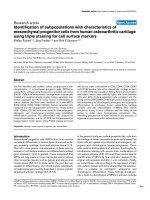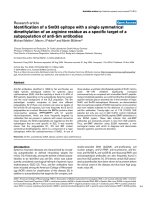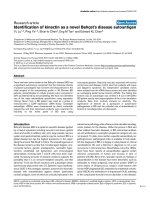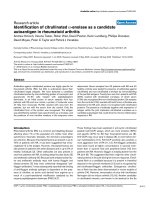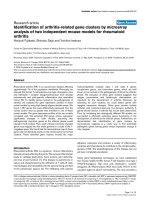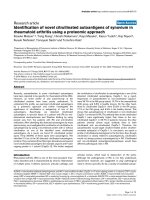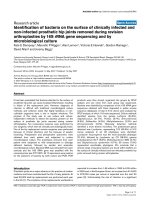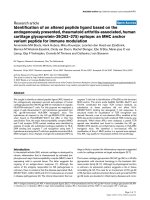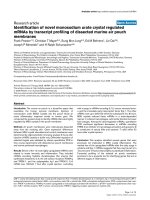Báo cáo y học: " Identification of a novel linear B-cell epitope in the UL26 and UL26.5 proteins of Duck Enteritis Virus" doc
Bạn đang xem bản rút gọn của tài liệu. Xem và tải ngay bản đầy đủ của tài liệu tại đây (872.32 KB, 9 trang )
RESEARC H Open Access
Identification of a novel linear B-cell epitope in
the UL26 and UL26.5 proteins of Duck Enteritis
Virus
Xiaoli Liu, Zongxi Han, Yuhao Shao, Dan Yu, Huixin Li, Yu Wang, Xiangang Kong
*
, Shengwang Liu
*
Abstract
Background: The Unique Long 26 (UL26) and UL26.5 proteins of herpes simplex virus are known to function
during the assembly of the viruses. However, for duck enteritis virus (DEV), which is an unassigned member of the
family Herpesviridae, little information is available about the function of the two proteins. In this study, the C-
terminus of DEV UL26 protein (designated UL26c), which contains the whole of UL26.5, was expressed, and the
recombinant UL26c protein was used to immunize BALB /c mice to generate monoclonal antibodies (mAb). The
mAb 1C8 was generated against DEV UL26 and UL26.5 proteins and used subsequently to map the epitope in this
region. Both the mAb and its defined epitope will provide potential tools for further study of DEV.
Results: A mAb (designated 1C8) was generated against the DEV UL26c protein, and a series of 17 partially
overlapping fragments that spanned the DEV UL26c were expressed with GST tags. These peptides were subjected
to enzyme-linked immunosorbent assay (ELISA) and western blotting analysis using mAb 1C8 to identify the
epitope. A linear motif,
520
IYYPGE
525
, which was located at the C-terminus of the DEV UL26 and UL26.5 proteins,
was identified by mAb 1C8. The result of the ELISA showed that this epitope could be recognized by DEV-positive
serum from mice. The
520
IYYPGE
525
motif was the minimal requirement for reactivity, as demonstrated by analysis
of the reactivity of 1C8 with several truncated peptides derived from the motif. Alignment and comparison of the
1C8-defined epitope sequence with those of other alphaherpesviruses indicated that the motif
521
YYPGE
525
in the
epitope sequence was conserved among the alphaherpesviruses.
Conclusion: A mAb, 1C8, was generated against DEV UL26c and the epitope-defined minimal sequence obtained
using mAb 1C8 was
520
IYYPGE
525
. The mAb and the identified epitope may be useful for further study of the
design of diagnostic reagents for DEV.
Background
Herpesviruses exist widely in nature. The geno mes of
herpesviruses consist of linear double-stranded DNA;
they differ in size (from approximately 124 to 235 kb),
sequence arrangement and base composition [1], and
vary significantly with respect to the presence and
arrangement of inverted and directly repeated
sequences. The genomes of most of the alphaherpes-
viruses, such as herpes simplex virus 2 (HSV-2) [2] and
Marek’s disease virus 1 (MDV-1) [3], encode more than
70 proteins; some of these proteins are not essential for
the replication of the viruses. Only limited information
is available about the structures and functions of t hese
70 proteins, although some studies of the antigenic
determinants of the glycoproteins have been reported
[4,5]. Three types of capsid, named A-, B-, and C-cap-
sids, are needed in the ass embly of HSV-1 [6]. B-capsids
lack DNA but may be the important intermediates in
virus assembly [7-10]. The unique feature of B-capsids
is the presence of an abundant core protein, named
scaffolding protein ICP35 (VP22a) [6,11-13], which is
encoded by the in-frame gene UL26.5.Thisprotein
is present in the B-ca psids of the HSV-1 assembly but is
absent after the completion of DNA encapsidation and
is not found in the mature virion [14].
* Correspondence: ;
Division of Avian Infectious Diseases, National Key Laboratory of Veterinary
Biotechnology, Harbin Veterinary Research Institute, the Chinese Academy of
Agricultural Sciences, Harbin 150001, the People’s Republic of China
Liu et al. Virology Journal 2010, 7:223
/>© 2010 Liu et al; licensee BioMed Central Ltd. This is an Open Access article distributed under the terms of the Cre ative Commons
Attribution License (http:// creativecommons.org/licenses/by/2.0), which permi ts unrestricted use, distribution, and reproduction in
any medium, provided the original work is pro perly cited.
Duck enteritis virus (DEV), an unassigned member of
the family Herpesviridae [15], is the cause of duck viral
enteritis (DVE), which is also known as duck plague
(DP), a disease of Anseriformes.DVEisaformof
hemorrhagic enteritis that occurs in captive or free-fly-
ing waterfowl [16] and causes heavy economic losses in
commercial duck production [17]. The DEV establishes
an asymptomatic carrier state in waterfowl in the course
of infection, and it is only detectable during the inter-
mittent shedding period of the infection [18]. Currently,
only limited information is available on the genomic
sequence and encoded proteins of DEV; therefore the
development of diagnostic methods based on virus
detection is difficult. Hence, the development of immu-
nity based prophylactic, therapeutic, and diagnostic
techniques for the control DEV is of significance.
The DEV has a linear double-stranded DNA genome
of approximately 180 kb with a G+C content of 64.3%
[16]. The genes and their arrangements in the DEV UL
region have been reported by our laboratory [19-23].
Our results have demonstrated that DEV UL26 and
UL26.5, two nested in-frame genes, encode a capsid
maturation protease and the minor capsid scaffold pro-
tein of DEV [20].
B-cell epitopes are antigenic determinants that are
recognized and bound by membran e-associated recep-
tors on the surface of B lymphocytes [24]. They can be
classified into two ty pes: linear ( continuous) epitopes
and conformational (discontinuous) epitopes. Linear epi-
topes are short peptides that correspond to a contiguous
amino acid sequence within a protein [25,26]. To date,
there has been no study of the B-cell epitopes of DEV.
In this study, we first expressed the 360 amino acids in
the C-terminus of the DEV UL26 protein (named
UL26c), which contain the whole sequence of UL26.5.
Subsequently, we generated a monoclonal antibody
(mAb) (named 1C8) against DEV UL26 by vaccination
of mice with a recombinant UL26c prime and DEV par-
ticle boost. Finally, we identified an epitope in the DEV
UL26 protein which was recognized by the mAb 1C8.
These results will provide a basic understanding of the
structure, function and localization of the DEV UL26
protein and UL26.5 protein. This mAb and the recombi-
nant proteins could be used as a potential tool for the
design of diagnostic reagents for DEV.
Results
Production of the recombinant protein UL26c
Owing to the difficulty of expressing the whole UL26
gene (in total 2124 bp in length) of DEV, we used pro-
karyotic expression of the C-terminal 360-amino acid
(348-707aa) protein in E. coli BL21 (DE3) after induc-
tion by Isopropyl-b-D-thiogalactopyranoside (IPTG) and
termed the recombinant protein UL26c. Western
blotting using murine antibody against DEV showed
that UL26c could react with DEV antibody (Figure 1A),
which implied that it had similar antigenicity to native
DEV UL26 protein. The UL26c was used to prime
immunity and DEV particles were used as boost anti-
gens to prepare the mAb.
Generation of mAb against the DEV UL26 protein
One hybridoma clone that secreted mAb specific to the
DEV U L26 protein was selected and designated as 1C8.
The subclass of 1C8 was determined to be IgM with
light chain. Both western blotting and ELISA showed
that 1C8 could react specifically with both chicken
embryonic fibroblasts (CEF) infected with DEV (Figure
1B and Figure 1C) and the recombinant protein UL26c
(Figure 1D and Figure 1C). In summary, we can con-
clude that the mAb 1C8 recognized the DEV UL26 pro-
tein specifically.
Mapping and identification of the epitope of UL26
protein
For fine mapping of the epitope of DEV UL26 that was
recognized by mAb 1C8, a set of GST fused proteins
(Figure 2) were expressed in prokaryotes and used
together to identify the epitope by both western blotting
and ELISA. Western blotting showed that the peptide
F2 (432-577aa) was recognized by mAb 1C8 (Figure
3A). The further screening results showed that both F2-
2 (471-525aa) and F 2-3 (511-577aa) could react with
mAb 1C8, while F2-1 (432-485aa) failed to be recog-
nized (Figure 3A). These results indicated that the over-
lapping sequence shared by F2-2 a nd F2-3 may contain
the epitope recognized by mAb 1C8. Hence, to def ine
the epitope defined by mAb 1C8 in the UL26 protein
more precisely, a series of truncated peptides (from F4
to F 1 4; Figure 2) that were deleted successively from
the amino or carboxyl terminuses of the overlapping
fragment were expressed, respectively, for subsequent
screening of mAb 1C8. The results showed that the
mAb 1C8 reacted with peptides from F4 (511-525aa) to
F12 (520-525aa) (Figure 3B and Figure 3C), but not with
F13 (519-524aa) and F14 (521-525aa) (Figure 3C).
Therefore, we considered that the motif
520
IYYPGE
525
is
the defined minimal epitope in the UL26 protein of the
DEV Clone-03 strain that is recognized by mAb 1C8,
because deletion of I
520
or E
525
destroyed the binding of
the GST fusion peptides by mAb 1C8. In addition, the
results were confirmed further by ELISA (Figure 3D).
Reaction of the epitope peptide with duck anti-DEV
antibody
The recombinant peptide, F12 (
520
IYYPGE
525
), was used
as an antigen to react with mouse anti-DEV antibody in
this study. The results of both western blotting and
Liu et al. Virology Journal 2010, 7:223
/>Page 2 of 9
ELISA showed that this p eptide defined by mAb 1C8
could react with murine anti-DEV a ntibody (Figure 4),
which demonstrated that the epitope had good reactivity.
Alignment of the 1C8-defined sequences in
alphaherpesviruses
The mAb 1C8-defined motif and flanking sequences in
the UL26 protein of alphaherpesviruses were aligned
and analyzed. The results showed that the epitope
defined by mAb 1C8,
520
IYYPGE
525
, was relatively con-
served in alphaherpesviruses (Figure 5). Interestingly,
EHV-1 and EHV-4 have the same amino acid residues
as DEV in the motif defined by mAb 1C8. Two residue s
of the epitope,
521
YY
522
, were highly conserved among
the alphaherpesviruses, except for the residue F
521
in
VZV. In addition, the C-terminus of the amino acids of
the epitope was highly conserved among m ost of the
alphaherpesviruses selected for this study (Figure 5).
Discussion
Formation of the herpesvirus capsid is the first step in
viral morphogenesis. The capsid of HSV-1 is found in
thematurevirionsandinthenuclei of infected cells
from which they originate. There are three distinct types
of capsid, A-, B- and C-capsids, in infected cells [6]. The
B-capsids of HSV-1 contain a large amount of the scaf-
folding protein (the product of the UL26.5 gene), and
smaller amounts of VP24 and VP21, the products of th e
UL26 gene. The UL26 and UL26.5 genes are expressed
as 3’-coterminal transcripts, and the promoter for the
UL26.5 gene is located within the coding region of t he
UL26 gene in HSV-1 [27-29]. The UL 26 gene encodes a
self-cleaved protease that generates the capsid proteins
VP21 and VP24 [30]. Cleavage of the UL26 and UL26.5
proteins is not required for capsid assembly, but the
cleavage event is essential for DNA encapsidation [31].
The UL26.5 gene encodes the scaffold protein VP22a
[27], which has been linked to a family of proteins
named infected-cell protein 35 (ICP35). The VP2 2a is
the most a bundant protein found in the B-capsid and
may form the scaffold of the HSV-1 B-caps id [32]. T he
B-capsid is similar to the capsid found in infectious
HSV-1 particles, except that it lacks DNA. The cavity of
the B-capsid is occupied instead by a proteinaceous core
Figure 1 Reactivity of mAb 1C8 with DEV and recombinant UL26c protein by western blotting and ELISA. A) The western blotting results
showed the reactivity of recombinant protein UL26c with murine anti-DEV serum; E. coli BL 21 (DH3) without induction was used as a negative
control. B) Western blotting results showed the reactivity of CEF infected with DEV with mAb 1C8; normal CEF were used as negative controls.
C) The ELISA results showed the reactivities of DEV in CEF with mAb 1C8 and the recombinant protein UL26c with mAb 1C8; SPF mouse sera
were used as negative controls. D) The recombinant protein UL26c was probed with mAb 1C8. E. coli BL 21 (DH3) without induction was used
as a negative control.
Liu et al. Virology Journal 2010, 7:223
/>Page 3 of 9
1 707UL26
348 449 561 707
432 577
F1 F3
F2
432 485
471
525
577
511
F2-2
F2-3
F2-1
511
525
512
514
515
516
517
518
519
520
519
525
525
525
525
525
525
525
524
525
F4
F5
F6
F7
F8
F9
F10
F11
F12
348 707UL26c
F14521
525
F13
Figure 2 Schematic diagram showing the truncated fragments derived from the UL26c protein of DEV Clone-03 strai n and their
relative positions. Letters represent the amino acid positions in the UL26 protein. The names of the peptides are as in Table 1. The bars
represent peptides of the truncated DEV UL26 proteins. The peptides that were negative in western blotting and ELISA with mAb 1C8 are
shown in gray and the peptides that were positive in western blotting and ELISA with mAb 1C8 are shown in pink.
Figure 3 Precise localization of the epitope defined by mAb 1C8. The reactivity of mAb 1C8 with different truncated recombinant proteins
was determined by western blotting and ELISA. The names of the proteins are the same as in Table 1. Recombinant GST (rGST) protein was
used as a negative control in both the western blotting and indirect ELISA. A) The western blotting results of mAb 1C8 with peptides F1, F2, F3,
F2-1, F2-2 and F2-3. B) The western blotting results of mAb 1C8 with peptides F4, F5, F6, F7, F8, F9 and F10. C) The western blotting results of
mAb 1C8 with peptides F11, F12, F13 and F14. D) The results of ELISA of mAb 1C8 with the 17 recombinant proteins. The pink columns
indicated the results of the ELISA of mAb 1C8 with the 17 recombinant proteins and the green columns are negative controls, which showed
the results of ELISA of SP2/0 cell culture media with the recombinant proteins.
Liu et al. Virology Journal 2010, 7:223
/>Page 4 of 9
that is removed when DNA enters [32]. The UL26 pro-
teinase cleaves the products of the UL26.5 gene, and
itself, at a site 25 amino acids from the C terminus of
its product [27]. DEV is an unassigned member in the
family Herpesviridae and, to date, there has been no
report of the structure and function of proteins UL26
and UL26.5 in DEV. It has been reported that the genes
UL26 and UL26.5 in DEV are similar to their homolo-
gues in other alphaherpesviruses [20]. It has been specu-
lated that they have similar functions in viral infection
and replication to those of HSV-1 and other
alphaherpesviruses.
In this study, we expressed the C-terminus of DEV
UL26 and immuni zed mice with both recombinan t pro-
tein UL26c and the DEV particles, using a prime-boost
protocol, and one mAb (1C8) was generated by cell
fusion. Interestingly, six bands were detected in DEV-
infected CEFs in western blotting analysis using mAb
1C8 in this study (Figure 1B). These may have origi-
nated from cleavage by the products of the UL26 gene.
Figure 6 shows the proteins that are predicted to origi-
nate from the products of the DEV UL26 and UL26.5
by the alignment of the homologous in HSV-1. The
DEV UL26 gene encodes a deduced protein o f 707
amino acids [20]. Comparison of the amino acids in
DEV UL26 with the homologous in H SV-1 showed that
DEV UL26 contains two sites. The release site (R) was
at amino acids 281 and 282, and the maturational site
(M) was at amino acids 677 and 678. Self-cleavage by
UL26 may yield the pr oteolytically active VP24-like pro-
tein and VP21-like protein (Figure 6) [30], which are
approximately 31 kD and 43 kD, respectively. The
UL26.5 gene is in frame with UL26; therefore, the
UL26.5-encoded proteins possess the same M site as the
Figure 4 Reactivity of the identif ied epitope (F12:
520
IYYPGE
525
) with antibodies against DEV. A) The peptide that corresponded to the
epitope defined by mAb 1C8 was used as the coating antigen in an ELISA, and purified rGST protein was used as a negative control. The
murine anti-DEV antibody was used as the primary antibody and SPF mouse sera were used as negative antibody controls. B) The western
blotting results of the epitope defined by mAb 1C8 with the murine antibody against DEV; the rGST and E. coli BL 21 (DH3) without induction
were used as negative controls.
DDQLDGDN IYYPGESVYLG RGSIRGGQQPL
DATTRDDLEG IYYPGE
R S PRPGER
DANTRDDIEG IYYPGE
R S PRPVER
PTP YYAPA
A P PQLLPP
DQRELDS FYSGE
S QMDG
DHPRGRSGGGDDDEAYYPGE
G A PAELPP
EPLRSRGGG DDEAYYPGE
G A PAELPP
DQDEPDA DYPYYPGE
ARGA PRGVDS
GRDEPDR DFPYYPGE
ARPE PRPVDS
DYDDRD DAPYYPGE
ARAP PRVVPDSGGRGR
DHDDRD DAAYYPGE
ARAP RFAPDSAG R
DRSIESD LYYPGE
FRRSNFSPPQASSMKYEET
DKSPEQE PYYPGE
FQQS EHRNLRCEDG
DKYDEPD LYYPGE
LSRH EPHYEGEGKNVGP
HPN YYSSN
FG QFPG
DEV
EHV-1
EHV-4
PRV
VZV
BHV-1
BHV-5
HSV-1
HSV-2
CeHV-1
CeHV-2
M
DV-1
M
DV-2
HVT
ILTV
Figure 5 Alignment of the sequences in the epitope motif with
14 herpesviruses in subfamily Alphaherpesvirinae. The epitope
sequences are underlined and the amino acid residues in the
epitope region that are shared by different herpesviruses are shown
in red. Hyphens indicated the deleted amino acid residues. EHV:
equine herpesvirus; PRV: pseudorabies virus; VZV: varicella-zoster
virus; BHV: bovine herpesvirus; HSV: herpes simplex virus; CeHV:
cercopithecine herpesvirus; MDV: Marek’s disease virus; HVT: turkey
herpesvirus; ILTV: infectious laryngotracheitis virus.
Liu et al. Virology Journal 2010, 7:223
/>Page 5 of 9
UL26 protein. Consequently, we hypothesized that the
six bands detected using western blotting in this study
may indicate the six products of UL26 and UL26.5.
A series of 17 fragments that spanned the UL26c pro-
tein were expressed with a GST tag in this study, and
used to screen for the minimal epitope recognized by
mAb 1C8 using western blotting and ELISA. It was
demonstrated that the minimal sequence of the epitope
defined by mAb 1C8 appeared to be
520
IYYPGE
525
,
because any deletion of residues from either end of
520
IYYPGE
525
destroyed the ability of mAb 1C8 to bin d.
Comparative analysis of the amino acid sequences of
the identified epitope with those of another 14 alpha-
herpesviruses revealed that the C-terminus of the linear
B-cell epito pe
521
YYPGE
525
is conserved among the
selected alphaherpesviruses, except PRV, VZV and
ILTV. It has been reported previously that the motif
YYPGE is conserved in the scaffold proteins of alpha-
herpesviruses [33]. It was reported that deletion of a 9-
amino acid motif from the HSV-1 UL26.5, comprising
amino acids 143 to 151, which contained the sequence
YYPGE, did not affect the fo rmation of capsids in vitro
but had a specific effect on incorporation of the portal.
This indicated that this deletion had blocked DNA
packing but had not interfered with the assembly of B-
capsids [33,34]. Therefore, the 9-amino acid motif that
contains YYPGE is required for the formation of portal-
containing capsids in HSV-1-infected cells, and it is
essential for the production of infectious virus [34].
However, in DEV, the function of the motif needs
further investigation.
The result of the in vitro neutralization test showed
that mAb 1C8 could not neutralize the infectivit y of
DEV. The absence of neutralizing activity against DEV
might i ndicate that this region has low immunogenicity
or, more probably, that this region is not exposed on
the surface of the virion. Indeed, the products of the
HSV-1 UL26 gene are components of viral capsids,
which are located inside of the viral tegument and
envelope, while the products of the UL26.5 gene are
components of B-capsids [28]. The products encoded by
the two genes show predominantly nuclear localization
within infected cells [35]. The B-capsids are accumu-
lated in the nucleus prior to viral DNA encapsidation
[36] and the predominant component of B-capsids is
the product of the UL26.5 gene, which also contains the
sequences of the epitope defined by 1C8.
The mAb 1C8 and its epitope, which was defined in
this study, may prove to be very useful tools for the
development of immunity-based therapeutic and diag-
nostic techniques for DEV, although the mAb l acked
neutralizing ability.
Conclusion
In this study, we generated a mAb, 1C8, and identified a
novel linear B-cell epitope on the DEV UL26 and
UL26.5 proteins using this mAb. The identified epitope
and mAb 1C8 may increase our understanding of the
function and loc ati on of the UL26 and UL26.5 proteins
in DEV. It will also be a potential tool for the design of
diagnostic reagents for DEV.
Methods
Cells and virus strain
The SP2/0 cells were maintained in Dulbecco’s Modified
Eagle’s Medium (DMEM) (Invitrogen, USA) supplemen-
ted with 10% fetal bovine serum (FBS) (Invitrogen,
USA) and 1% penicillin-streptomycin in a humidified 5%
CO
2
atmosphere at 37°C. Chicken embryo fibroblasts
(CEF) were prepared from 9- to 11-day-old specific-
pathogen-free (SPF) embryonated eggs according to
standard procedures. The DEV Clone-03 strain was pur-
ified from a commercial Chinese DEV vaccine using the
plaque assay, as described previously [19]. The virus was
propagated in CEF in DMEM with 8% FBS and har-
vested when the cytopathic effect (CPE) reached 80%.
After three freeze-thaw cycles, cell lysates were con-
firmed primarily by electron microscopy (JEM-12 00 EX,
Japan) and polymerase chain reaction (PCR) [20].
Gene cloning, construction of recombinant expression
vectors and expression of fusion proteins
Given that it is difficult to induce prokaryotic expression
of the full UL26 gene, we expressed a fragment of 1083
bp at the C-terminus of the DEV UL26 gene (UL26c)by
Met
R-site
A-281/S-282
A-677/S-678
M-site
UL26
UL26.5
UL26/677
UL26/281
UL26/281/677
UL26.5/327
Figure 6 Schematic representation of UL26 and UL26.5 in the
DEV Clone-03 strain. The location of the R and M cleavage sites
are indicated by the arrows and the dashed lines indicate the
cleavage sites. The results were based on the alignment of the
structure of UL26 in DEV and HSV-1 [36,39]. The sequence of the
epitope is indicated by the yellow bars. Each of the proteins is
designated by UL26 or UL26.5 plus the sites of cleavage. The pink
bars represent the amino acid sequence that contains the epitope
defined by mAb 1C8. The gray bars represent the proteins that
were not recognized by mAb 1C8.
Liu et al. Virology Journal 2010, 7:223
/>Page 6 of 9
amplifying the gene fragment from DEV Clone-03. The
sequences and lo cations of the primers used for amplifi-
cation and expression of the gene in this study are
shown in Table 1.
After constructio n, each recombinant expression con-
struct was transformed into E. coli BL21 (DE3) (Nova-
gen, Gibbstown, NJ, USA). A series of fusion proteins
with the expected molecular weights were induced by
IPTG and stained with Coomassie blue after SDS-PAGE
as described previously [37]. For preparation of purified
proteins, inclusion body proteins were separated by
SDS-PAGE, the proteins of interest were excised, and
the gel slices were crushed and added to an appropriate
volume of sterilized PBS. The extracted proteins were
used for western blotting and ELISA.
Generation of mAbs against the DEV UL26 protein
Three 8-week-old BALB/c mice were primed subcuta-
neously with DEV virus particles mixed with an equal
volume of Freund’s complete adjuvant (Sigma, USA),
followed by two boosts of immunization with the
recombinant protein UL26c. The protocols used for
the preparation of mAbs and ascitic fluid have been
described previously [37,38]. All hybridomas were
cloned by at least three rounds of limiting dilution.
The class and subclass of the mAb produced were
determined using an SBA Clonotyping™ System/HRP
kit (Southern Biotechnology Associates, Birmingham,
USA).
SDS-PAGE and western blotting
The specificity and reactivity of the mAb 1C8 were also
determined by western blotting using recombinant
UL26c protein and CEF infected by DEV, respectively.
Purified recom binant UL26c protein, truncated proteins
and DEV in CEF were separated by denaturin g SDS-
PAGE. For western blotting, all t he proteins and the
virus were transferred onto nitrocellulose membranes,
and detected as described previously [37]. Purified
recombinant GST (rGST) protein and the CEF were
used as negative antigen controls.
Indirect ELISA
The reactivity of the mAb with different truncated
recombinant UL26 proteins was determined further by
ELISA as described previously [37]. Briefly, the purified
recombinant proteins were used as coating antigens,
applied at 10 μg/well in 0.1 M carbonate buffer (pH 9.6)
at 4°C for 12 h, and blocked with 0.5% BSA at 37°C for
1 h. After washing three times with PBST, 100 μlof
mAb were added to the wells and incubated at 37°C for
1 h. The plates were washed three times and incubated
with HRP-conjugated sheep anti-mouse secondary anti-
body at 37°C for 1 h. The color was developed and the
Table 1 Sequences of the primers used in this study
Fragments Primer sequences (5’ -3’)
a
Position in UL26
gene
b
Size of amplicon
(bp)
Sense Negative sense
UL26c
GGATCCATGCAATCTACTATGACG GTCGACTCAACATCTATTACACATCA 1042-2124 1083
F1
GGATCCATGCAATCTACTATGACG GTCGACTTACAGCTGCCCTCCCTGGAC 1042-1347 306
F2
GGATCCATGTATGGACAGCCTGTTTAT GTCGACTTAAGCTAATGGTCCAGTAGA 1294-1731 438
F3
GGATCCATGCCTACTGGACAAGGTAAC GTCGACTCAACATCTATTACACATCA 1681-2124 444
F2-1
GGATCCATGTATGGACAGCCTGTTTAT CTTTGGTCGACTTAATCTCCAGATTCGACGGC 1294-1455 162
F2-2 TGCAG
GGATCCATGGCAATTGCTGCAGATAGG CTTTGGTCGACTTATTCCCCCGGATAATAGAT 1411-1575 165
F2-3 TGCAG
GGATCCATGAATGACGACCAGTTAGAT GTCGACTTAAGCTAATGGTCCAGTAGA 1531-1731 201
F4 TGCAG
GGATCCATGAATGACGACCAGTTAGAT CTTTGGTCGACTTATTCCCCCGGATAATAGAT 1531-1575 45
F5 TGCAG
GGATCCATGGACGACCAGTTAGATGGT CTTTGGTCGACTTATTCCCCCGGATAATAGAT 1534-1575 42
F6 TGCAG
GGATCCATGCAGTTAGATGGTGACAAT CTTTGGTCGACTTATTCCCCCGGATAATAGAT 1540-1575 36
F7 TGCAG
GGATCCATGTTAGATGGTGACAATATC CTTTGGTCGACTTATTCCCCCGGATAATAGAT 1543-1575 33
F8 TGCAG
GGATCCATGGATGGTGACAATATCTAT CTTTGGTCGACTTATTCCCCCGGATAATAGAT 1546-1575 30
F9 TGCAG
GGATCCATGGGTGACAATATCTATTAT CTTTGGTCGACTTATTCCCCCGGATAATAGAT 1549-1575 27
F10 TGCAG
GGATCCATGGACAATATCTATTATCCG CTTTGGTCGACTTATTCCCCCGGATAATAGAT 1552-1575 24
F11 TGCAG
GGATCCATGAATATCTATTATCCGGGG CTTTGGTCGACTTATTCCCCCGGATAATAGAT 1555-1575 21
F12 TGCAG
GGATCCATGATCTATTATCCGGGGGAA CTTTGGTCGACTTATTCCCCCGGATAATAGAT 1558-1575 18
F13
GATCCATGATCTATTATCCGGGGTAAG TCGACTTACCCCGGATAATAGATCATG 1558-1572 15
F14
GATCCATGTATTATCCGGGGGAATAAG TCGACTTATTCCCCCGGATAATACATG 1561-1575 15
a
The introduced restriction enzyme sites (Bam HI and Sal I) in each primer are underlined. The stop codon, TCA, of the DEV UL26 gene and the introduced start
and stop codons in the primers of the UL26 fragments are shown in bold, respectively.
b
The nucleotide positions correspond to those of the DEV UL26 gene, GenBank accession no. EF203709.
Liu et al. Virology Journal 2010, 7:223
/>Page 7 of 9
reaction terminated, and the absorbance was measured
at 490 nm. All assays were performed in triplicate.
In vitro neutralization test
The mAb 1C8 was tested for the presence of DEV-neutra-
lizing antibodies. The CEF lysates containing DEV were
mixed with ascites fluid containing mAb 1C8 and incu-
bated at 37°C for 1 h; unrelated ascites fluid and PBS, used
as negative controls, were treated in the same way. The
mixture was added to the prepared CEF and incubated at
37°C. After 2 h of incub ation, the mixture was removed
and the cells were overlaid with 1% low-melting-point
aga rose containing 8% FBS. At 72 h post-i ncubation, the
cells were overlaid again with 1% low-melting-point agar-
ose containing 0.1% Ponceau. After further incubation at
37°C for 24 h, the plaques were counted and compared.
Detection of the reactivity of the epitope defined by mAb
1C8
To investigate whether the peptides could be recognized
by anti-DEV antibody, the epitope peptide F12 was puri-
fied and used as antigen to coat ELISA plates (10 μg/
well) to react with mouse anti-DEV antibody and mouse
sera, respectively. Purified rGST was used as the nega-
tive control for F12. In addition, the purified F12 and
rGST were also used to detect the reactivity of the
epitope peptide by western blotting.
Homologous analysis of the sequence of the epitope
defined by mAb 1C8
The mAb 1C8-defined epitope sequences and flanking
sequences of DEV were compared with those of 14
other selected herpesviruses of the Alphaherpesvirinae
using the MEGALIGN program in Lasergene (DNAStar)
with CLUSTAL W multiple alignments, as described
previously [23]. The 14 herpesviruses used in this study
were as follows: equine herpesvirus 1 (EHV-1)
(NC_001491), equine herpesvirus 4 (EHV-4)
(AF030027), pseudorabie s virus (PRV) (BK001744), vari-
cella-zoster virus (VZV) (NC_001348), bovine herpes-
virus 1 (BHV-1) (AJ004801), b ovine herpesvirus 5
(BHV-5) (AY261359), herpes simplex virus type 1
(HSV-1) (X14112), herpes simplex virus type 2 (HSV-2)
(NC_001798), cercopithecine herpesvirus 1 (CeHV-1)
(NC_004812), cercopithecine herpesvirus 2 (CeHV-2)
(NC_006560), Marek’s disease virus 1 (MDV-1)
(AF243438), Marek’sdiseasevirus2(MDV-2)
(AB049735), turkey herpesvirus (HVT) (AF291866), and
infectious laryngotracheitis virus (ILTV) (NC_006623).
Authors’ contributions
XL, SL and XK designed research; XL, ZH, YS and DY performed research; XL,
SL, XK, HL and YW analyzed data; and XL, SL and XK wrote the paper. All
authors read and approved the final manuscript.
Competing interests
The authors declare that they have no competing interests.
Received: 28 April 2010 Accepted: 13 September 2010
Published: 13 September 2010
References
1. Weir JP: Genomic organization and evolution of the human
herpesviruses. Virus Genes 1998, 16:85-93.
2. Dolan A, Jamieson FE, Cunningham C, Barnett BC, McGeoch DJ: The
genome sequence of herpes simplex virus type 2. J Gen Virol 1998,
72:2010-2021.
3. Tulman ER, Afonso CL, Lu Z, Zsak L, Rock DL, Kutish GF: The genome of a
very virulent Marek’s diseases virus. J Gen Virol 2000, 74:7980-7988.
4. Zaripov MM, Morenkov OS, Fodor N, Schmatchenko VV: Distributions of B-
cell epitopes on the pseudorabies virus glycoprotein B. J Gen Virol 1999,
80:537-541.
5. Maeda K, Mizukoshi F, Hamano M, Kai K, Kondo T, Matsumura T:
Identification of another B-cell epitope in the type-specific region of
equine herpesvirus 4 glycoprotein G. Clin Diagn Lab Immunol 2005,
12:122-124.
6. Gibson W, Roizman B: Proteins specified by herpes simplex virus VIII.
Characterization and composition of multiple capsid forms of subtypes
1 and 2. J Virol 1972, 10:1044-1052.
7. Perdue ML, Cohen JC, Kemp MC, Randall CC, O’Callaghan DJ:
Characterization of three species of equine herpesvirus 1(EHV-1). Virology
1975, 64:187-204.
8. Perdue ML, Cohen JC, Randall CC, O’Callaghan DJ: Biochemical studies of
the maturation of herpes virus nucleocapsid species. Virology 1976,
74:194-208.
9. Prestion VG, Coates JA, Rixon FJ: Identification and characterization of a
herpes simplex virus gene product required for encapsidation of virus
DNA. J Virol 1983, 45:1056-1064.
10. Sherman G, Bachenheimer SL: Characterization of intranuclear capsids
made by ts morphogenic mutants of HSV-1. Virology 1988, 163:471-480.
11. Newcomb WW, Brown JC: Use of Ar plasmid etching to localize structural
proteins in the capsid of herpes simplex virus type 1. J Virol 1989,
63:4697-4702.
12. Newcomb WW, Brown JC: Structure of the herpes simplex virus capsid:
effects of extraction with quanidine hydrochloride and partial
reconstitution of extracted capsids. J Virol 1991, 65:613-620.
13. Newcomb WW, Trus BL, Booy FP, Cross C, Wall JS, Brown JC: Structure of
the herpes simplex virus capsid molecular composition of the pentons
and triplexes. J Mol Biol 1993, 232:499-511.
14. Homa FL, Brown JC: Capsid assembly and DNA packing in Herpes
Simplex Virus. Rev Med Virol 1997,
7:107-122.
15. Davison AJ, Eberle R, Ehlers B, Hayward GS, McGeoch DJ, Minson AC,
Pellett PE, Roizman B, Studdert MJ, Thiry E: The order Herpesvirales. Arch
Virol 2009, 154:171-177.
16. Gardner R, Wikerson J, Johnson JC: Molecular characterization of the DNA
of Anatid Herpesvirus 1. Intervirology 1993, 36:99-112.
17. Leibovitz L, Hwang J: Duck plague on the American continent. Avian Dis
1968, 12:361-378.
18. Burgess EC, Ossa J, Yuill M: Duck plague: A carrier state in waterfowl.
Avian Dis 1979, 23:940-949.
19. Li H, Liu S, Kong X: Characterization of the genes encoding UL24, TK and
gH proteins from duck enteritis virus (DEV): a proof for the classification
of DEV. Virus Genes 2006, 33:221-227.
20. Liu S, Chen S, Li H, Kong X: Molecular characterization of the herpes
simplex virus 1 (HSV-1) homologues, UL25 to UL30, in duck enteritis
virus (DEV). Gene 2007, 401:88-96.
21. An R, Li H, Han Z, Shao Y, Liu S, Kong X: The UL31 to UL35 gene
sequences of duck enteritis virus correspond to their homologs in
herpes simplex virus 1. Acta Virol 2008, 52:23-30.
22. Li H, Liu S, Han Z, Shao Y, Chen S, Kong X: Comparative analysis of the
genes UL1 through UL7 of the duck enteritis virus and other
herpesviruses of the subfamily alphaherpesvirinae. Genet Mol Biol 2009,
32:121-128.
23. Liu X, Liu S, Li H, Han Z, Shao Y, Kong X: Unique sequence characteristics
of genes in the leftmost in the leftmost region of unique long region in
duck enteritis virus. Intervirology 2009, 52:291-300.
Liu et al. Virology Journal 2010, 7:223
/>Page 8 of 9
24. Baggio R, Burgstaller P, Hale SP, Putney AR, Lane M, Lipovsek D, Wright MC,
Roberts RW, Liu R, Szostak JW, Wagner RW: Identification of epitope-like
consensus motifs using mRNA display. J Mol Recognit 2002, 15:126-134.
25. Barlow DJ, Edwards MS, Thornton JM: Continuous and discontinuous
protein antigenic determinants. Nature 1986, 322:747-748.
26. Langeveld J, Martinez-Torrecuadrada J, Boshuizen R, Meloen R, Ignacio C:
Characterization of a protective linear B cell epitope against feline
parvoviruses. Vaccine 2001, 19:2352-2360.
27. Liu FY, Roizman B: The herpes simplex virus 1 gene encoding a protease
also contains within its coding domain the gene encoding the more
abundant substrate. J Virol 1991, 65:5149-5156.
28. Liu F, Roizman B: Characterization of the protease and other products of
amino-terminus-proximal cleavage of the herpes simplex virus 1 UL26
protein. J Virol 1993, 67:1300-1309.
29. Desai P, Watkins SC, Person S: The size and symmetry of B capsids of
herpes simplex virus type 1 are determined by the gene products of
the UL26 open reading frame. J Virol 1994, 68:5365-5374.
30. DiIanni CL, Drier DA, Deckman IC, McCann PJ 3, Roizman B, Colonno RJ,
Cordingley MG: Identification of the herpes simplex virus-1 protease
cleavage sites by direct sequence analysis of autoproteolytic cleavage
products. J Biol Chem 1993, 268:2048-2051.
31. Gao M, Matusick-Kumar L, Hurlburt W, DiTusa SF, Newcomb WW, Brown JC,
McCann PJ 3rd, Deckman I, Colonno RJ: The protease of herpes simplex
virus type 1 is essential for functional capsid formation and viral growth.
J Virol 1994, 68:3702-3712.
32. Thomsen DR, Roof LL, Homa FL: Assembly of herpes simplex virus (HSV)
intermediate capsids in insect cells infected with recombinant
baculoviruses expressing HSV capsid proteins. J Virol 1994, 68:2442-2457.
33. Singer GP, Newcomb WW, Thomsen DR, Homa FL: Identification of a
region in the herpes simplex virus scaffolding protein required for
interaction with the portal. J Virol 2005, 79:132-139.
34. Huffman JB, Newcomb WW, Brown JC, Homa FL: Amino acids 143-150 of
the herpes simplex virus 1 scaffold protein are required for the
formation of portal-containing capsids. J Virol 2008, 82:6778-6781.
35. Stamminger T, Gstaiger M, Weinzierl K, Lorz K, Winkler M, Schaffner W:
Open reading frame UL26 of human cytomegalovirus encodes a novel
tegument protein that contains a strong transcriptional activation
domain. J Virol 2002, 76:4836-4847.
36. Weinheimer SP, McCann PJ, O’Boyle DR, Stevens JT, Boyd BA, Drier DA,
Yamanaka GA, DiIanni CL, Deckman IC, Cordingley MG: Autoproteolysis of
herpes simplex virus type 1 protease release an active catalytic domain
found in intermediate capsid particles. J Virol 1993, 67:5813-5822.
37. Xing JJ, Liu SW, Han ZX, Shao YH, Li HX, Kong XG: Identification of a novel
linear B-cell epitope in the M protein of Avian Infectious Bronchititis
Coronaviruses.
J Microbiology 2009, 47:589-599.
38. Kohler G, Milstein C: Continuous cultures of fused cells secreting
antibody of predefined specificity. Nature 1975, 256:495-497.
39. McGeoch DJ, Dalrymple MA, Davison AJ, Dolan A, Frame MC, Mcnab D,
Perry LJ, Scott JE, Taylor P: The complete DNA sequence of the long
unique region in the genome of herpes simplex virus type 1. J Gen Virol
1988, 69:1531-1574.
doi:10.1186/1743-422X-7-223
Cite this article as: Liu et al.: Identification of a novel linear B-cell
epitope in the UL26 and UL26.5 proteins of Duck Enteritis Virus. Virology
Journal 2010 7:223.
Submit your next manuscript to BioMed Central
and take full advantage of:
• Convenient online submission
• Thorough peer review
• No space constraints or color figure charges
• Immediate publication on acceptance
• Inclusion in PubMed, CAS, Scopus and Google Scholar
• Research which is freely available for redistribution
Submit your manuscript at
www.biomedcentral.com/submit
Liu et al. Virology Journal 2010, 7:223
/>Page 9 of 9
